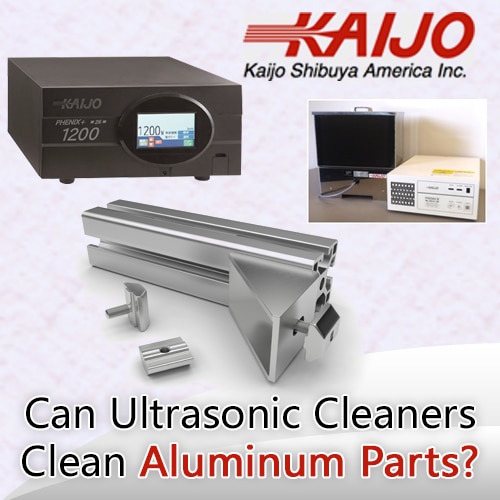Can Ultrasonic Cleaners Clean Aluminum Parts?
July 23, 2019
 Parts with hard surfaces such as those made from steel or brass are easy to clean with ultrasonic cleaners and low frequencies can clean these parts very quickly. For aluminum parts, getting rapid and effective cleaning without damaging the parts is more difficult. Aluminum is a softer metal and surfaces can suffer pitting in ultrasonic cleaning systems. At the same time, aluminum reacts with both acidic and base cleaners so a neutral cleaning solution is required for the ultrasonic bath. Ultrasonic cleaning system suppliers can propose the right industrial ultrasonic cleaners and help choose the best bath temperatures and cleaning solutions to clean aluminum parts quickly and completely.
Parts with hard surfaces such as those made from steel or brass are easy to clean with ultrasonic cleaners and low frequencies can clean these parts very quickly. For aluminum parts, getting rapid and effective cleaning without damaging the parts is more difficult. Aluminum is a softer metal and surfaces can suffer pitting in ultrasonic cleaning systems. At the same time, aluminum reacts with both acidic and base cleaners so a neutral cleaning solution is required for the ultrasonic bath. Ultrasonic cleaning system suppliers can propose the right industrial ultrasonic cleaners and help choose the best bath temperatures and cleaning solutions to clean aluminum parts quickly and completely.
How the Ultrasonic Frequency Affects Cleaning Performance
In general, parts with heavy contamination are cleaned with lower ultrasonic frequencies because the cleaning action of the cavitation bubbles is more intense. Low frequencies of 19.5 kHz and 26 kHz generate large bubbles that produce a high energy blast when they collapse at sound wave peaks. These blasts remove even the toughest dirt but can also result in surface pitting and damage for delicate parts. For fragile parts or parts with soft surfaces, frequencies of 38 kHz or higher have to be used.
If the cleaning application regularly cleans a variety of parts, including steel and aluminum components, an ultrasonic cleaning system that can produce two or more frequencies should be used. That way, steel and similar rugged parts can be cleaned quickly at low frequencies. For aluminum parts, higher frequencies can be used but the lower energy of the smaller cavitation bubbles will result in increased cleaning times.
Shortening Cleaning Times at Higher Frequencies
There are several measures that allow for more rapid ultrasonic cleaning at all frequencies but for the lowest frequencies these methods are often not needed. If cleaning takes substantially longer because of the higher frequencies used for cleaning aluminum parts, ultrasonic baths can be heated and cleaning agents can be added to the cleaning solution.
Depending on the type of contaminant to be removed, cleaning agents are usually acidic or bases. Aluminum is a highly reactive element that suffers from corrosive action from both acids and bases. As a result, neither can be used in the ultrasonic bath.
Putting these factors and restrictions together, cleaning aluminum parts in a heated, high-frequency ultrasonic bath with a neutral detergent will give the best results. The heat softens grease and oily residue while the detergent helps dissolve contaminants. The higher frequency creates small, low-energy cavitation bubbles that will not damage the aluminum surface. Such an industrial ultrasonic cleaning system will clean aluminum parts rapidly, removing all traces of dirt, even in hard-to-reach places, crevices and dead-end holes.
Kaijo Can Help Choose the Right Aluminum Cleaning System
Selecting the right industrial ultrasonic cleaner frequencies, power, heating capability and cleaning tanks suitable for cleaning aluminum can be a challenge. The ultrasonic generators have to be able to produce one or more frequencies or a range of frequencies right for the aluminum parts. The tanks have to be suitable for the proposed cleaning solution and have to have the right heating characteristics. System power has to be adequate and a basket to hold delicate parts may be needed.
Kaijo has the long-term experience with industrial ultrasonic cleaners and in house expertise to evaluate these characteristics for specific customer applications. The company can analyze the industrial cleaning requirements for aluminum parts and recommend components and turn-key systems from their extensive line of industrial ultrasonic cleaners. Kaijo’s systems will clean all components, including aluminum parts, and deliver performance that far exceeds that of conventional cleaning methods. Contact Kaijo for a free consultation to review the requirements of your industrial cleaning application.






